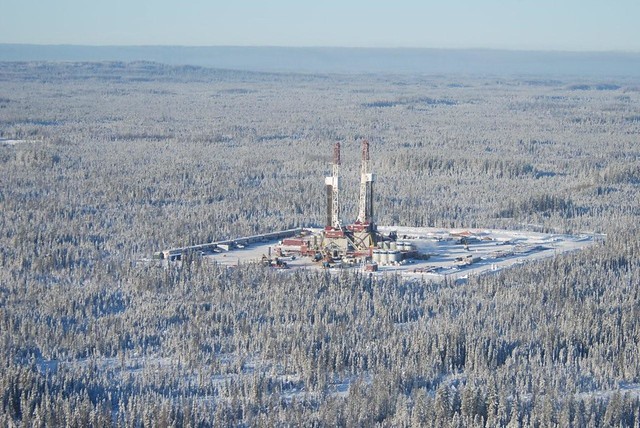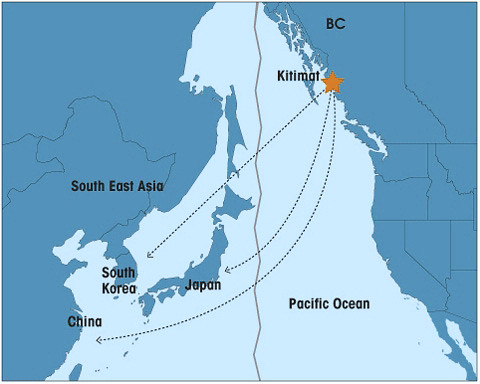
Source: Kitimat LNG Image Library, kitimatlngfacility.com
The Chevron-Apache Kitimat LNG export project in British Columbia has the potential to capitalize on Canada’s vast natural gas resources, as well as the proximity of its western coast to Asian markets. But it is also up against competition from producing countries like Australia, where the buildout of LNG export infrastructure is already well underway, and the US, where existing LNG import terminals and gas pipelines provide a foundation of infrastructure upon which new LNG export plants can build at lower cost and in less time.
And Kitimat LNG will not reach a final investment decision until around 70% of the project’s offtake committed under long-term, and likely oil-linked, contract. “LNG that comes out of the United States made in the United States, it’s perfectly okay for it to be pricee off of Henry Hub. LNG that is made in Australia, East Africa or Canada it’s a harder proposition to see why you would introduce a regional market reference to those markets,” said president of gas and midstream Joe Geagea during the company’s third-quarter earnings call on Friday.
A Barclays report, “Double Trouble”, released yesterday, suggests that requirement could put Kitimat at a disadvantage. Barclays analysts noted that while global LNG buyers are increasingly looking for gas-linked supply contracts, Canadian project developers are holding out for oil-linked contracts, and offering equity participation. “This strategy, however, is proving increasingly unattractive to buyers as gas-linked LNG is making inroads not only into the US, but also into other parts of the world,” Barclays analysts wrote.
But Chevron has repeatedly stressed that for Kitimat to be a viable project, it must be backed by long-term off take agreements with a strong price foundation. “Greenfield LNG projects are unlikely to be developed outside of the United States unless its significant portion of the offtake is committed under long term contracts with robust pricing that underpins the financial investment required to monetize these resources,” said Geagea.
He argued that equity participation offers buyers a means of gaining direct exposure to North American gas prices, and that oil linkage is flexible enough to ensure LNG prices do not reach unmanageable levels for importers.
“For the last 40 years, the industry has learned to operate within an oil framework that saw oil prices go up to $140 and go down to $20,” Geagea said. “Within this traditional framework you can introduce S curves, you can moderate slopes, there are a lot of other levers that actually work to prevent LNG from becoming very unaffordable in the regions where affordability is becoming an issue. We can address those excursions that could be harmful from an affordability point of view within a traditional framework without necessarily going to something unproven that could also be a lot more volatile.”

Source: Kitimat LNG Image Library, kitimatlngfacility.com
Geagea and other Chevron executives also laid out a litany of other factors that could enable Kitimat to compete with other LNG export projects in the US, Canada and elsewhere.
- Low, stable Henry Hub prices are not a given.
“A common perception is [with] Henry Hub-linked pricing…landed LNG prices in Asia will be significantly less than other world sources. We think that’s not automatically a given,” said Geagea.
“US liquefaction cost are likely to rise as more projects compete for resources, including engineering contractors, fabrication yard space and project financing. Growing demand in the United States where new petrochemical projects, power plants, exports to Mexico and a transportation segment will mean new demand pull on the same supply base. Coupled with weather and storage effects this could easily increase price strength and volatility for Henry Hub.”
- Kitimat has the advantage on input costs.
Feedstock costs: “If you look at our acquisition of that resource base, we are very, very pleased with the entry price,” said general manager of investor relations Jeff Gustavson. “We have a huge resource base in both Liard and the Horn River. And that resource base sits right at the gate of North Asia, where we continuously see increased demand. So strategically, it is very well-positioned for North Asia buyers and our buyers see that and that’s the value proposition would have been communicated to them.”
Labor costs: “If we are the first out of the gate, we will have an ability to attenuate that versus being the last one coming in to develop the project,” said Gustavson. Kitimat has an edge over Canadian projects in that it is at a more advanced stage of permitting.
Pipeline costs. “We are not building a pipeline from the field to the LNG facility,” said Geagea. “We are clearly leveraging existing trunklines that are operated and owned by others…that’s very essential for us to actually control that, to control the feed going into the LNG facility. Where we can we are leveraging other facilities, infrastructures, processing plants.”
- Canada broadly supports energy exports.
“[LNG buyers] see a settled government and a provincial government that are supportive and understand the opportunity. They see a country that is very much in favor of exports and coping toward Asia. They see a project with export permits in hand and a clear line of sight on a pipeline and a transportation solution.” Chevron has stressed in the past that part of what attracted the company to the project is the relatively advanced stage of its permitting process.
Kitimat may have some distinct advantages, but looking broadly at Canada’s LNG sector, Barclays anticipates that competition with projects offering gas-linked contracts and the need to build out pipeline infrastructure from producing to exporting areas will push completion of any of Canada’s larger facilities out past 2020.
By that time, provided that US prices rise as expected, Canadian projects may benefit from a feedstock cost advantage. “Even when LNG exports begin, Canadian markets may not see an up-tick in prices, in our view, as the facilities will be drawing from gas wells that are yet to be drilled. In fact, the development of gas resources in conjunction with the export plants could result in greater production than the liquefaction facilities can take, leaving the domestic market with more, not less, gas to cover its needs,” said Barclays.
